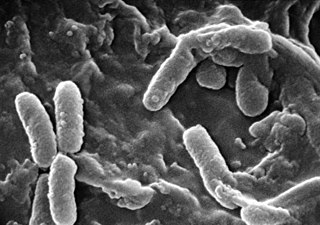
Pneumonia is an inflammatory condition of the lung primarily affecting the small air sacs known as alveoli. Symptoms typically include some combination of productive or dry cough, chest pain, fever, and difficulty breathing. The severity of the condition is variable.

Cryptogenic organizing pneumonia (COP), formerly known as bronchiolitis obliterans organizing pneumonia (BOOP), is an inflammation of the bronchioles (bronchiolitis) and surrounding tissue in the lungs. It is a form of idiopathic interstitial pneumonia.

The Nocardiaceae are a family of aerobic, non-fastidious, high G+C, Gram-positive actinomycetes that are commonly found in soil and water. Members of this family have been isolated from Antarctic soils. Nocardiaceae present coccobacilli, filamentous or, rarely, fragmented and palisading forms, and filamentous species grow in a branching morphological pattern similar to fungal hyphae.

Pseudomonas infection refers to a disease caused by one of the species of the genus Pseudomonas.
Legionella rubrilucens is a Gram-negative bacterium from the genus Legionella which was isolated from tap water in Los Angeles, hot spring water in Niigata in Japan, and a patient who suffered from pneumonia.
Gordonia is a genus of gram-positive, aerobic, catalase-positive bacterium in the Actinomycetota, closely related to the Rhodococcus, Mycobacterium, Skermania, and Nocardia genera. Gordonia bacteria are aerobic, motile, and non-sporulating. Gordonia is from the same lineage that includes Mycobacterium tuberculosis. The genus was discovered by Tsukamura in 1971 and named after American bacteriologist Ruth Gordon.. Many species are often found in the soil, while other species have been isolated from aquatic environments. Gordonia species are rarely known to cause infections in humans.
Gordonia alkanivorans is a bacterium from the genus of Gordonia which has been isolated from soil which was contaminated with tar and phenol in Rositz in Germany. Gordonia alkanivorans has the ability to metabolize hexadecane. The strain RIPI90A of Gordonia alkanivorans can desulfurize dibenzothiophene.
Gordonia araii is a Gram-positive and aerobic bacterium from the genus of Gordonia which has been isolated from human sputum in Japan.
Gordonia caeni is a Gram-positive, strictly aerobic, short-rod-shaped and non-motile bacterium from the genus Gordonia which has been isolated from sludge from a sewage disposal plant in Daejeon in Korea.
Gordonia cholesterolivorans is a bacterium from the genus Gordonia which has been isolated from sewage sludge from a sewage treatment plant in Ciudad Real in Spain. Gordonia cholesterolivorans has the ability to degrade cholesterol.
Gordonia defluvii is a Gram-positive and non-motile bacterium from the genus Gordonia which has been isolated from activated sludge foams in Australia.
Gordonia effusa is a bacterium from the genus Gordonia which has been isolate from human sputum in Japan.
Gordonia humi is a Gram-positive and non-spore-forming bacterium from the genus Gordonia which has been isolated from soil near the mushroom Agaricus brasiliensis in Taiwan.
Gordonia neofelifaecis is a bacterium from the genus Gordonia which has been isolated from faeces from the leopard in the Sichuan Province in China.
Gordonia otitidis is a bacterium from the genus Gordonia which has been isolated from a patient with external otitis in Japan.
Gordonia paraffinivorans is a bacterium from the genus Gordonia which has been isolated from the Daqing Oil Field in China. Gordonia paraffinivorans has the ability to degrade hydrocarbon.
Gordonia rhizosphera is a bacterium from the genus Gordonia which has been isolated from rhizosphere soil from a mangrove plant in Japan.
Gordonia shandongensis is a bacterium from the genus Gordonia which has been isolated from farmland soil in China.
Gordonia sihwensis is a Gram-positive and nitrate-reducing bacterium from the genus of Gordonia which has been isolated from an autotrophic denitrification reactor in Sihwa in Korea.
Gordonia soli is a bacterium from the genus of Gordonia which has been isolated from soil in Taiwan.



